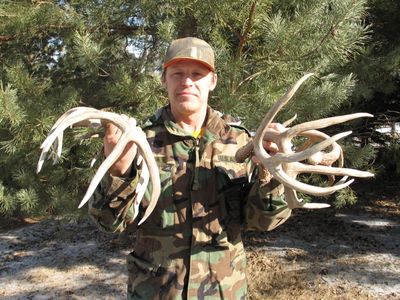Big-game harassment by antler gatherers increasing
Elk denied critical time to recover from hard winter

Big-game hunting seasons are closed, but overzealous people scavenging for shed antlers may be harassing elk to death, Washington Fish and Wildlife Department biologists say.
Elk weakened by another tough winter are still on their winter ranges trying to gain strength. They need to be left alone, they say.
“They used to go out in April or May, but as shed hunting has become more popular, more and more people are going out earlier, to the point that it’s become a factor in the survival of the elk,” said Pat Fowler, Washington’s wildlife biologist for the Blue Mountains.
Even though most elk didn’t start shedding antlers until late February or March, people were out scouting for bulls in January and early February to see where they were wintering, Fowler said.
“The shed hunters run those hillsides every day and that tends to break up the bull groups, reducing their security, and send them into the deeper snow on the north slopes when they should be down lower where they can expend less energy and find more food.”
Antler gathering has become more popular in recent years as state hunting rules have allowed more bulls to survive and grow large antlers. As the dropped antlers get larger — and more profitable on various markets — shed hunters have become more competitive.
Indeed, it’s reached the point of being disgusting, said Gerald Michaels, who’s gathered shed antlers occasionally around his home in the Yakima area for years.
This year he witnessed a group of men near a big-game feeding site near Nile scattered widely on a slope and forcing a group of elk to run.
It appeared as though the men were chasing the elk back and forth in hopes the jostling would dislodge any antlers remaining on the bulls.
Whether the shed hunters were chasing the elk or simply looking for antlers doesn’t matter, as far as Oak Creek Wildlife Area Manager John McGowan is concerned.
At this time of year, he told the Yakima Herald-Republic, the result is the same. It’s deadly for the elk.
“These are herd animals,” McGowan said. “Somebody says, ‘Oh, there’s no elk here,’ and they park their car and walk up to the ridge, and there’s 200 elk there. And that one guy will chase 200 elk.
“Of that 200 head, there some that are already very near death in February, March and April, and they’ll run also, even if they’re just hanging on to that last little bit of energy.
“And they won’t make it the next two weeks, or the month. They will die.”
The state’s feeding program in the Yakima region, designed to help the elk through the winter and now that orchards have gobbled up their prime winter range, may also be attracting the shed hunters.
Elk-populated state wildlife areas in Central Washington are closed until May 1 to prevent disturbance to wintering elk at feed sites. But overzealous shed hunters often ignore the signs.
“Back in the mid-’90s there were almost no big bulls here, before the spike-only (hunting) law,” said Bruce Berry, McGowan’s assistant manager at Oak Creek. “Now we have thousands of people coming to the feed site and they’re looking out and seeing all these big bulls. A lot of these folks probably just see dollar signs on those bulls’ heads.”
“Most people figure this is one time they can go out and pick up a nice set of horns,” said Terry Betker, a longtime shed hunter who uses elk antlers to create Native American artwork.
It’s a vicious cycle, McGowan said.
As shed hunting becomes more popular, more arrive at Oak Creek, to pick around the periphery — not necessarily in the closed area, but in the surrounding National Forest area in which many of the elk disperse. And as more arrive, others begin to arrive — earlier.
“I’ve been trying for years to get some sort of season on shed hunting to prevent disturbing elk on their winter range, but I haven’t got anywhere,” said Fowler, who sees the same problem from his base in Walla Walla.
“It would be difficult to manage since the elk are on private ground as well as national forests, neither of which the Fish and Wildlife Department controls.”